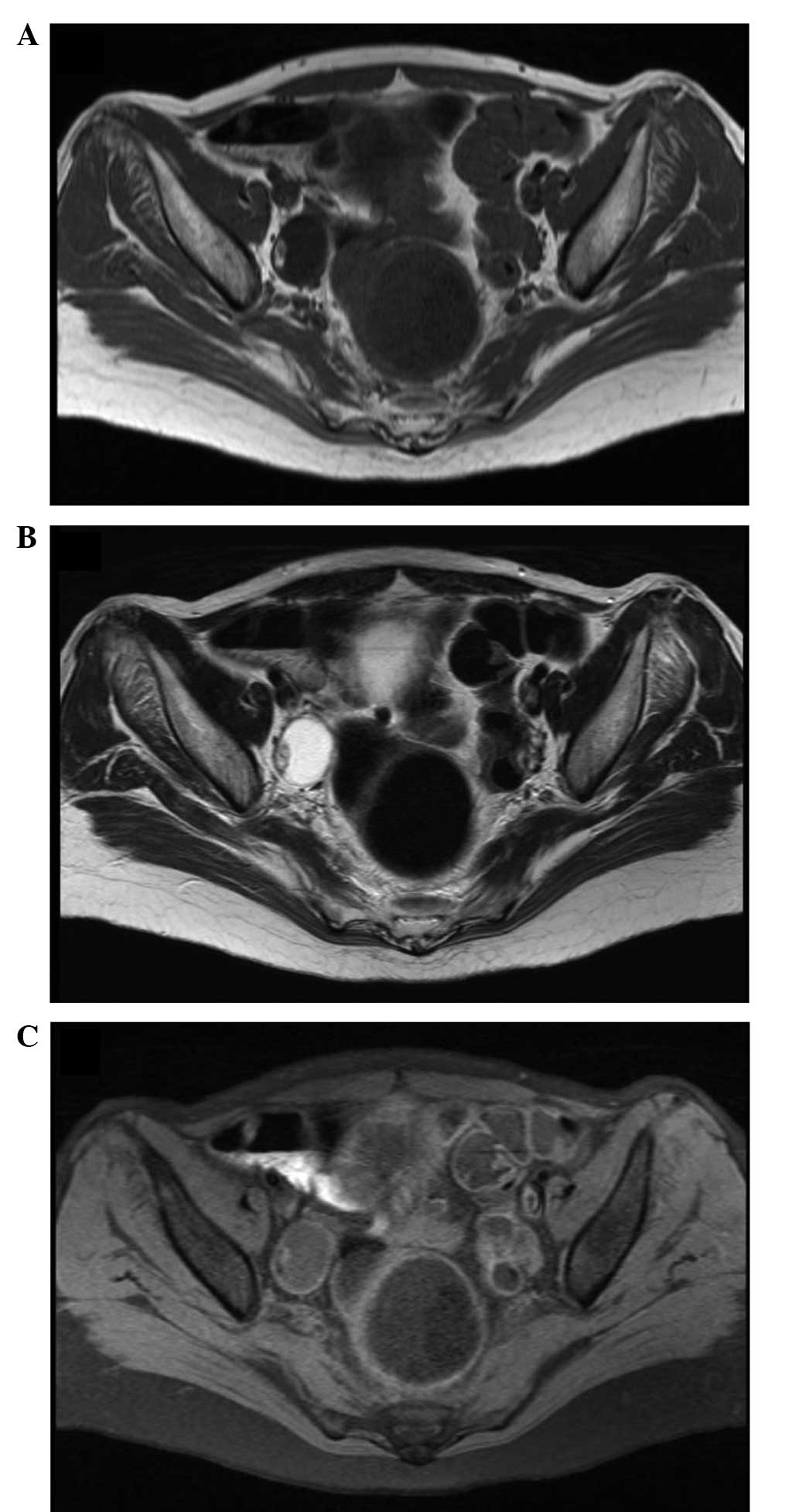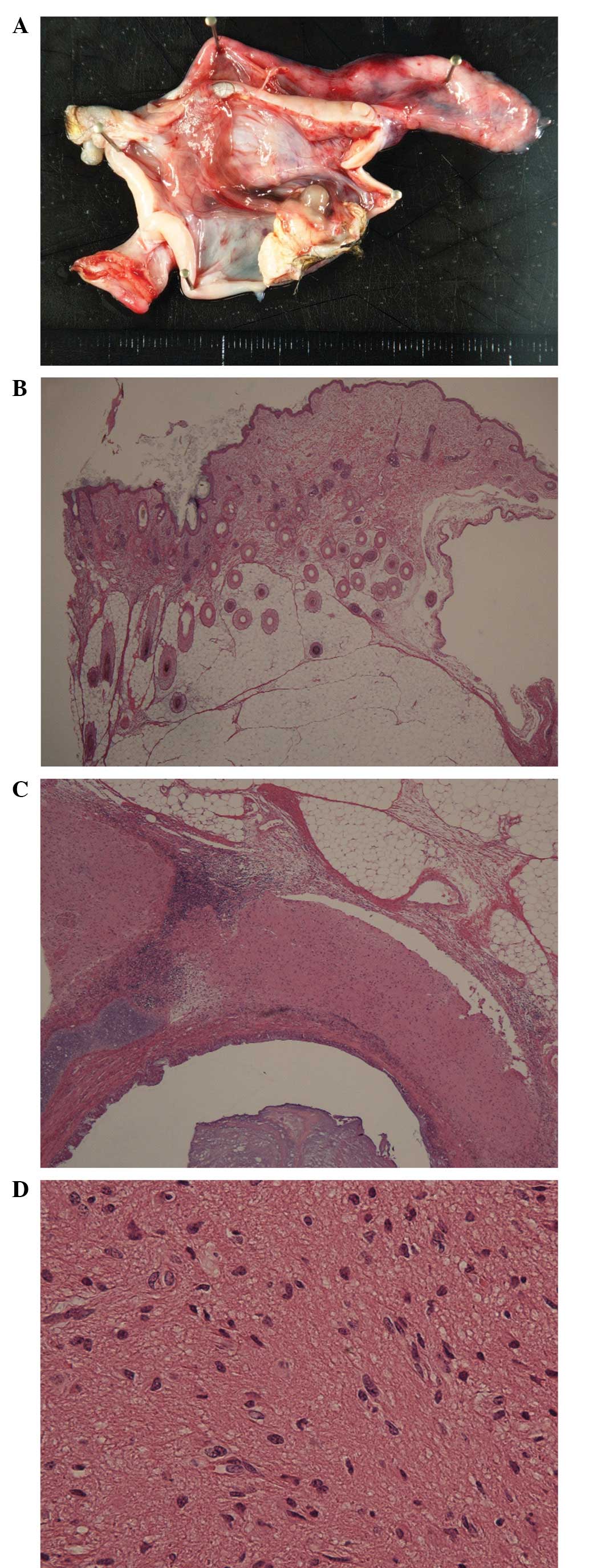Complete recovery from paraneoplastic anti-NMDAR encephalitis associated with a small ovarian teratoma following a laparoscopic salpingo-oophorectomy: A case report
- Authors:
- Published online on: March 11, 2015 https://doi.org/10.3892/etm.2015.2344
- Pages: 1723-1726
Abstract
Introduction
Ovarian teratoma-associated encephalitis was first reported in 1997 (1,2). In 2007, an association was identified between this type of encephalitis and N-methyl-D-aspartate receptor (NMDAR) antibodies (3). NMDAR is a ligand-gated cation channel, comprising NR1 and NR2 subunits, that serves crucial functions in synaptic transmission and plasticity (4). Overactivation of NMDAR may result in excitotoxicity, which contributes to the development of epilepsy, dementia and stroke. Conversely, low NMDAR activity results in symptoms that resemble schizophrenia (5). The autoantibodies produced in patients with concurrent anti-NMDAR encephalitis and teratoma exhibit cross-reactivity with the NMDAR in the teratoma, binding to the NR subunits of NMDAR following entry into the cerebrospinal fluid.
Anti-NMDAR encephalitis is a severe condition that is treatment-responsive. The disorder was initially identified in young females with an ovarian teratoma. These patients developed mood, behavior and personality abnormalities that resembled acute psychosis. The symptoms of anti-NMDAR encephalitis include neuropsychiatric symptoms, hyperkinesia, autonomic dysfunction, hypoventilation and epilepsy. Anti-NMDAR encephalitis is generally considered to be a paraneoplastic disease due to the rapid clinical improvement typically observed in patients following an ovariectomy. However, in certain patients, no teratoma or other tumor types are detected; thus, the exact prevalence and incidence of this disease remain unknown (2).
The present study reports a rare case involving a patient with anti-NMDAR encephalitis and severe neurological symptoms. Following a laparoscopic salpingo-oophorectomy, the patient exhibited a rapid recovery.
Case report
Written informed consent was obtained from the patient's family. A 39-year-old woman with no significant medical history was admitted to the the Department of Obstetrics and Gynecology, Osaka City University Graduate School of Medicine (Osaka, Japan) with a 5-day history of fever and stomach ache. The patients symptoms initially resembled those of the common cold. However, one week later, the patient experienced hallucinations and emotional lability. Blood testing and brain computed tomography (CT) scans indicated no abnormalities. However, the condition progressed, and the patient exhibited deteriorated emotional lability, increased disorientation and progressive dyskinesia, which was characterized by chorea of the body and limbs. An examination of the cerebrospinal fluid detected a cell count of 77-mm3, with a high number of monocytes. However, the head CT examination performed upon arrival revealed no notable abnormalities. Initially, limbic-herpes encephalitis was considered as a diagnosis; thus, the patient was administered acyclovir (1,5000 mg-day, 7 days) and received steroid pulse therapy (solu-medrol 1,000 mg-day, 3 days, 3 courses). However, the patient subsequently developed apnea. Therefore, a tracheal intubation, mechanical ventilation and plasmapheresis were performed. A lumbar puncture, serum viral analysis, head CT and magnetic resonance imaging (MRI) examinations were unable to clarify the etiology of the patients symptoms. Therefore, anti-NMDAR encephalitis was considered as a potential diagnosis, and mediastinal and pelvic CT examinations were conducted to detect the presence of a teratoma. An abdominal CT scan revealed a 24×24-mm cystic lesion in the pelvis, which appeared to be an ovarian teratoma. Furthermore, pelvic MRI revealed a right ovarian teratoma (Fig. 1). In addition, serum and cerebrospinal fluid samples were collected, and were determined to be positive for anti-NMDAR antibodies. A laparoscopic right salpingo-oophorectomy was subsequently performed. Intraoperatively, the right ovary was observed to be enlarged to 30 mm, while the left ovary remained at a normal size (Fig. 2). Pathological examination confirmed the diagnosis of a mature right ovarian cystic teratoma, containing neural tissue (Fig. 3).
The patient underwent postoperative steroid therapy (prednisolone 20 mg-day) until discharge, and the condition was observed to improve gradually. Mechanical respiratory support was no longer required by postoperative day 15, and the patient opened her eyes and began speaking on postoperative day 20, until which the patient had been comatose. Furthermore, the patients mental symptoms exhibited notable improvement, and the patient achieved complete recovery by postoperative day 53.
Discussion
Anti-NMDAR encephalitis is an autoimmune antibody-mediated form of limbic encephalitis, that was initially reported by Dalmau et al in 2007 (3). Anti-NMDAR encephalitis frequently occurs in young women, at a median age of 23 years (5). Commonly observed symptoms include psychiatric symptoms, involuntary movement of the face and limbs, consciousness disturbances and central hypoventilation. The clinical progression of anti-NMDAR encephalitis typically begins with symptoms that resemble the common cold, which subsequently progress to a period of psychiatric symptoms, followed by an immobile period and a hyperactive period (6). This clinical course was observed in the present case. A definitive diagnosis can be achieved following the detection of anti-NMDAR antibodies in the cerebrospinal fluid and serum.
A previous study reported that 40% of patients with anti-NMDAR encephalitis are aged <18 years (median age, 14 years), while older female patients develop ovarian teratomas more frequently compared with younger patients. Statistically, 31% of female patients aged <18 years and 56% of female patients aged >18 years exhibited teratomas (7). However, the incidence of paraneoplastic anti-NMDAR encephalitis remains unknown.
A tumorectomy is an effective treatment method when cases of teratoma are detected at an early stage (5). In addition, steroid pulse therapy, gamma globulin therapy, plasmapheresis and immunosuppressant therapy are effective treatment methods (8,9). Although 75% of patients recover completely, severe and prolonged disease is possible, and the mortality rate of anti-NMDAR encephalitis is 7% (5).
The present study described a rare case involving a patient with anti-NMDAR encephalitis who rapidly recovered from severe neurological symptoms following a laparoscopic salpingo-oophorectomy. The patient exhibited neuropsychiatric symptoms, hyperkinesia, autonomic dysfunction, hypoventilation and epilepsy; however, no signs of meningitis were observed. The etiology of the patients symptoms was unable to be clarified by a lumbar puncture, serum viral analysis, head CT or MRI examination. Therefore, anti-NMDAR encephalitis was considered as a potential diagnosis. Abdominal CT examination revealed a teratoma in the patients right ovary. Furthermore, anti-NMDAR antibodies were detected in the cerebrospinal fluid and serum of the patient. Thus, the diagnosis of anti-NMDAR encephalitis was confirmed.
In conclusion, gynecologists should be aware that small ovarian teratomas may induce anti-NMDAR encephalitis. Removal of the NMDAR-expressing tumor reduces the serum and cerebrospinal fluid levels of the pathological autoantibody (10). The present case report demonstrates that complete recovery from the severe neurological symptoms of anti-NMDAR encephalitis is possible following surgical resection.
References
|
Nokura K, Yamamoto H, Okawara Y, Koga H, Osawa H and Sakai K: Reversible limbic encephalitis caused by ovarian teratoma. Acta Neurol Scand. 95:367–373. 1997. View Article : Google Scholar : PubMed/NCBI | |
|
Okamura H, Oomori N and Uchitomi Y: An acutely confused 15-year-old girl. Lancet. 350:4881997. View Article : Google Scholar : PubMed/NCBI | |
|
Dalmau J, Tüzün E, Wu HY, Masjuan J, Rossi JE, Voloschin A, Baehring JM, Shimazaki H, Koide R, King D, et al: Paraneoplastic anti-N-methyl-d-aspartate receptor encephalitis associated with ovarian teratoma. Ann Neurol. 61:25–36. 2007. View Article : Google Scholar : PubMed/NCBI | |
|
Lynch DR, Anegawa NJ, Verdoorn T and Pritchett DB: N-methyl-D-aspartate receptors: different subunit requirements for binding of glutamate antagonists, glycine antagonists and channel-blocking agents. Mol Pharmacol. 45:540–545. 1994.PubMed/NCBI | |
|
Dalmau J, Gleichman AJ, Hughes EG, Rossi JE, Peng X, Lai M, Dessain SK, Rosenfeld MR, Balice-Gordon R and Lynch DR: Anti-NMDA-receptor encephalitis: Cases series and analysis of the effect of antibodies. Lancet Neurol. 7:1091–1098. 2008. View Article : Google Scholar : PubMed/NCBI | |
|
Iizuka T, Sakai F, Ide T, Monzen T, Yoshii S, Iigaya M, Suzuki K, Lynch DR, Suzuki N, Hata T and Dalmau J: Anti-NMDA receptor encephalitis in Japan: Long-term outcome without tumor removal. Neurology. 70:504–511. 2008. View Article : Google Scholar : PubMed/NCBI | |
|
Florance NR, Davis RL, Lam C, Szperka C, Zhou L, Ahmad S, Campen CJ, Moss H, Peter N, Gleichman AJ, et al: Anti-N-methyl-D-aspartate receptor (NMDAR) encephalitis in children and adolescents. Ann Neurol. 66:11–18. 2009. View Article : Google Scholar : PubMed/NCBI | |
|
Ishiura H, Matsuda S, Higashihara M, Hasegawa M, Hida A, Hanajima R, Yamamoto T, Shimizu J, Dalmau J and Tsuji S: Response of anti-NMDA receptor encephalitis without tumor to immunotherapy including rituximab. Neurology. 71:1921–1923. 2008. View Article : Google Scholar : PubMed/NCBI | |
|
Sansing LH, Tüzün E, Ko MW, Baccon J, Lynch DR and Dalmau J: A patient with encephalitis associated with NMDA receptor antibodies. Nat Clin Pract Neurol. 3:291–296. 2007. View Article : Google Scholar : PubMed/NCBI | |
|
Seki M, Suzuki S, Iizuka T, Shimizu T, Nihei Y, Suzuki N and Dalmau J: Neurological response to early removal of ovarian teratoma in anti-NMDAR encephalitis. J Neurol Neurosurg Psychiatry. 79:324–326. 2008. View Article : Google Scholar : PubMed/NCBI |












